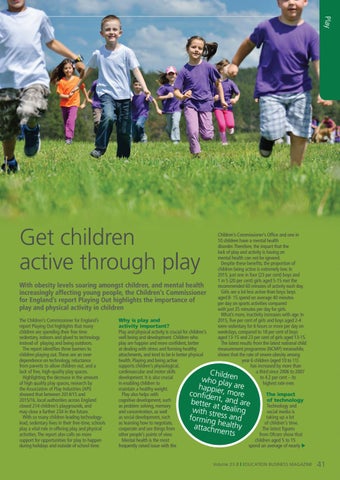Play
Get children active through play
Children’s Commissioner’s Office and one in 10 children have a mental health disorder. Therefore, the impact that the lack of play and activity is having on mental health can not be ignored. Despite these benefits, the proportion of children being active is extremely low. In 2015, just one in four (23 per cent) boys and 1 in 5 (20 per cent) girls aged 5-15 met the With obesity levels soaring amongst children, and mental health recommended 60 minutes of activity each day. Girls are a lot less active than boys: boys increasingly affecting young people, the Children’s Commissioner aged 8- 15 spend on average 40 minutes for England’s report Playing Out highlights the importance of per day on sports activities compared play and physical activity in children with just 25 minutes per day for girls. What’s more, inactivity increases with age. In The Children’s Commissioner for England’s Why is play and 2015, five per cent of girls and boys aged 2-4 report Playing Out highlights that many activity important? were sedentary for 6 hours or more per day on children are spending their free time Play and physical activity is crucial for children’s weekdays, compared to 18 per cent of boys sedentary, indoors and glued to technology well being and development. Children who aged 13-15 and 23 per cent of girls aged 13-15. instead of playing and being outdoors. play are happier and more confident, better The latest results from the latest national child The report identifies three barriers to at dealing with stress and forming healthy measurement programme (NCMP) meanwhile, children playing out. These are an overattachments, and tend to be in better physical shows that the rate of severe obesity among dependence on technology, reluctance health. Playing and being active year 6 children (aged 10 to 11) from parents to allow children out, and a supports children’s physiological, has increased by more than lack of free, high-quality play spaces. cardiovascular and motor skills a third since 2006 to 2007 Childre Highlighting the decrease in the amount development. It is also crucial to 4.2 per cent – its n who pl of high quality play spaces, research by in enabling children to highest rate ever. a y a re happier the Association of Play Industries (API) maintain a healthy weight. confide , more showed that between 2014/15 and Play also helps with The impact nt, and 2015/16, local authorities across England cognitive development, such of technology better a are closed 214 children’s playgrounds, and as problem solving, memory Technology and t d e aling with str may close a further 234 in the future. and concentration, as well social media is With so many children leading technologyas social development, such taking up a lot forming ess and lead, sedentary lives in their free-time, schools as learning how to negotiate, of children’s time. attachmhealthy play a vital role in offering play and physical cooperate and see things from The latest figures ents activities. The report also calls on more other people’s points of view. from Ofcom show that support for opportunities for play to happen Mental health is the most children aged 5 to 15 during holidays and outside of school time. frequently raised issue with the spend an average of nearly E Volume 23.8 | EDUCATION BUSINESS MAGAZINE
41













